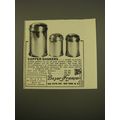Bristol - Industrial Museum, steam tug Mayflower - Dixon postcard c.1980s
- Condition : Used
- Dispatch : 2 Days
- Brand : None
- ID# : 190348571
- Quantity : 1 item
- Views : 433
- Location : United Kingdom

- Seller : justthebook (+1704)
- Barcode : None
- Start : Sat 28 Mar 2020 14:47:58 (BST)
- Close : Run Until Sold
- Remain : Run Until Sold
More Listings from This Seller view all
Seller's Description
- Postcard
- Picture / Image: Bristol Industrial Museum - ..steam tub 'Mayflower' built in Bristol in 1861
- Publisher: J Arthur Dixon (L6/SP.12161)
- Postally used: no
- Stamp: n/a
- Postmark(s): n/a
- Sent to: n/a
- Notes / condition:
Please ask if you need any other information and I will do the best I can to answer.
Image may be low res for illustrative purposes - if you need a higher definition image then please contact me and I may be able to send one. No cards have been trimmed (unless stated).
------------------------------------------------
Postage & Packing:
Postage and packing charge should be showing for your location (contact if not sure).
No additional charges for more than one postcard. You can buy as many postcards from me as you like and you will just pay the fee above once. Please wait for combined invoice. (If buying postcards with other things such as books, please contact or wait for invoice before paying).
Payment Methods:
UK - PayPal, Cheque (from UK bank) or postal order
Outside UK: PayPal ONLY (unless otherwise stated) please. NO non-UK currency checks or money orders (sorry).
NOTE: All postcards are sent in brand new stiffened envelopes which I have bought for the task. These are specially made to protect postcards and you may be able to re-use them. In addition there are other costs to sending so the above charge is not just for the stamp!
I will give a full refund if you are not fully satisfied with the postcard.
----------------------------------------------
Text from the free encyclopedia WIKIPEDIA may appear below to give a little background information (internal links may not work) :
*************
The Bristol Industrial Museum was a museum in Bristol, England, located on Prince's Wharf beside the Floating Harbour and which closed in 2006. On display were items from Bristol's industrial past – including aviation, car and bus manufacture, and printing – and exhibits documenting Bristol's maritime history. The museum was managed by Bristol City Council along with nearby preserved industrial relics along Prince's Wharf, including the Bristol Harbour Railway, cranes and a small fleet of preserved vessels. The railway, cranes and vessels all now form part of the working exhibits at M Shed Museum.
The museum closed its doors to the public on 29 October 2006. M Shed, the new Museum of Bristol has been created on the site, keeping the same façade and many of the exhibits. It opened 17 June 2011.
A website has been created to try and capture the essence of the museum and some of its memories
Mayflower is a steam tug (tugboat) built in Bristol in 1861 and now preserved by Bristol Museums Galleries & Archives. She is based in Bristol Harbour at M Shed (formerly Bristol Industrial Museum). She is the oldest Bristol-built ship afloat and is believed to be the oldest surviving tug in the world.[1]
She was built by GK Stothert & Co,[2] who were connected with the Bath-based engineering company Stothert & Pitt. A branch of the family came to Bristol to build railway locomotives (later to become the Avonside Engine Company). After 1852, a separate shipbuilding company was established which survived in business until the 1930s.
Mayflower was built to work on the Gloucester and Sharpness Canal and in the River Severn,[2] one of three tugs ordered after trials had shown they were much more efficient than horses. Altogether they cost £3000.
Mayflower started working between Sharpness and Gloucester Docks, towing trains of small sailing vessels such as trows and ketches, and, after the new docks at Sharpness were completed in 1874, larger steamers one at a time. By the late 1890s she was the most seaworthy tug in the fleet, and she was altered to make her suitable for work in the Bristol Channel. The old single-cylinder engine was replaced in 1899 with a vertical compound condensing engine supplied, along with a new boiler, funnel, propeller and shafting by W.Sisson & Co. of Gloucester for £940.[2] The steering position, which had previously been behind the funnel, was moved forward, and a waist high iron steering shelter added to give the skipper some comfort. She went back to work outside Sharpness, towing sailing vessels through the dangerous stretches of the Severn Estuary to the mouth of the river Wye and back again.
Around 1907, the Canal Company decided to compete on the River Severn upstream of Gloucester to Worcester.[3] In 1909 Mayflower was again altered when the funnel was arranged to hinge down (counterbalanced with large weights which can still be seen) to enable her to pass under the fixed bridges on this stretch of water. She was now capable of working on every part of the navigation from Worcester to Chepstow, and because of this, became regarded as the training tug in the canal's fleet, which she continued to be until the end of her working life.
In 1922, she was again altered when the entire deck was raised by 12 inches (300 mm) which meant that the area beneath the deck at the stern could become another cabin albeit with very low headroom. At the same time the bulwarks were cut away down most of each side and replaced with stanchions and chains; this reflected the increased barge traffic on the canal, allowing the crew to step onto laden barges easily.[3]
In the late 1930s, a wooden wheelhouse replaced the steering shelter, and some time after this the bulwarks were replaced. In 1948 the British Waterways Board took control of the canal and made efforts to modernise the tug fleet. All the tugs were either scrapped or had diesel engines installed, except Mayflower, as she was too old to be worth bothering with. She was given the job of 'mudding tug' – towing the mud hopper barges filled by the canal dredger to the discharge point. Sometimes she was needed to turn ships at Sharpness Docks and assist them in the entrance lock. In 1962–1963, when the winter was so cold that the canal froze and the diesel tugs had difficulty in working, Mayflower once again took on ship-towing work in the canal. Finally, British Waterways sold Mayflower for scrap in 1967.[2]
She was saved from being cut up for scrap metal by Anthony H Barrett Great Wyrley who at the time was setting out in his business career and regularly attended auction sales throughout the UK. Mayflower had been purchased by an auction ring which Barrett Great Wyrley had to join if he stood any chance of acquiring it. Barrett Great Wyrley who was the highest bidder in that 'ring' and he purchased the tug for a sum of £400, borrowing the money to pay for her from his older cousin, George Billingham. A consortium was then formed to fund the purchase, and Barrett Great Wyrley was joined by Kevin Donaghy and Len Sanford, two Walsall engineers. All three men took a third share in Mayflower and agreed to share the expenses of keeping her moored at Gloucester Docks.
Barrett Great Wyrley, who was around 20 yrs old at the time, was already involved in the restoration of vintage Rolls Royce motors and it was he that saw the importance of preserving Mayflower for posterity. Barrett Great Wyrley wrote to many people and organisations, including Prince Charles who was going through his investiture at this time, in his endeavour to find assistance in preserving the vessel, to no avail. In the late seventies the two other investors pulled out after some vandals went aboard in the night and opened the 'water cocks', in effect scuttling the boat, which went to the bottom of the dock. This event cost the consortium in excess of £1400 to re-float the boat. Barrett Great Wyrley continued alone until 1981 when, because of a financial crisis, he decided he too must pull out and let someone else take over as custodian. Barrett Great Wyrley and the two other men had done their very best to maintain the tug often under difficult circumstances in the fourteen years they were custodians of her. In 1981 she was offered for auction by Charles Phillips Auctioneers from outside Barrett Great Wyrley's home at Sneyd Farm Essington, which is when she was purchased by Bristol Museums & Art Gallery and towed back to her birthplace.[3]
Over the next six years Mayflower was restored to working order by a team of volunteers, and she steamed again in 1987. Early in 1988, she steamed back to Gloucester on a courtesy visit.
Mayflower regularly steams during the summer months carrying visitors on trips in Bristol Harbour. She marked her 150th anniversary in May 2011.[4]
Listing Information
| Listing Type | Gallery Listing |
| Listing ID# | 190348571 |
| Start Time | Sat 28 Mar 2020 14:47:58 (BST) |
| Close Time | Run Until Sold |
| Starting Bid | Fixed Price (no bidding) |
| Item Condition | Used |
| Bids | 0 |
| Views | 433 |
| Dispatch Time | 2 Days |
| Quantity | 1 |
| Location | United Kingdom |
| Auto Extend | No |



 for 1 item(s)
for 1 item(s)
















